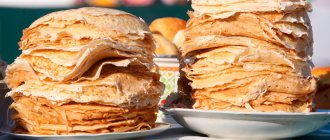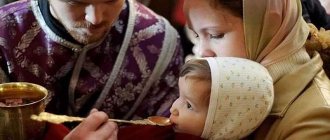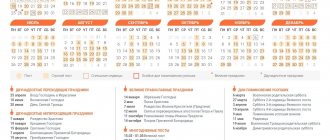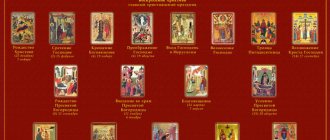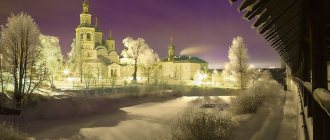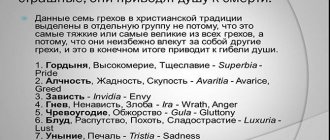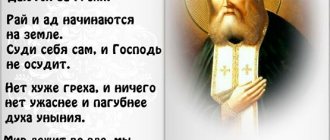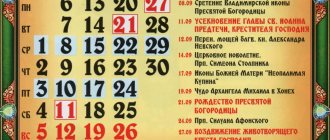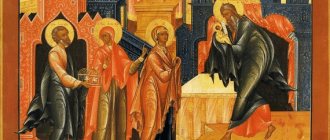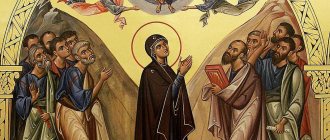The customs and traditions of the Russian people are inextricably linked with the calendar and church holidays . The famous Russian proverb says: “With God, every day is a holiday.” In fact, in the Orthodox calendar of holidays there are many memorable, significant days.
Icon of the Resurrection of Christ with the Passion Cycle and the Annual Menaion
In the Old Believer Church, the memory of saints glorified by the Church is celebrated every day. All church holidays are a veneration of the Higher and ethereal powers. Many church holidays are dedicated to special events, memories of biblical history, the appearance of miraculous icons, Old Testament and New Testament saints.
List of Orthodox holidays and dates
Below is a list of the most revered Orthodox holidays, indicating dates according to the new style.
Easter and Twelfth Feasts:
- Easter is a moving holiday;
- Nativity of the Blessed Virgin Mary - September 21;
- Exaltation of the Holy Cross - September 27;
- Presentation of the Blessed Virgin Mary into the temple - December 4;
- Christmas - January 7;
- Epiphany - January 19;
- Presentation of the Lord - February 15;
- Annunciation of the Blessed Virgin Mary - April 7;
- Palm Sunday is the closest Sunday before Easter, a moving holiday;
- The Ascension of the Lord is the 40th day after Easter, always on Thursday, a moving holiday;
- Feast of the Holy Trinity (Pentecost) - the 50th day after Easter, always on Sunday, a moving holiday;
- Transfiguration of the Lord - August 19;
- Dormition of the Virgin Mary - August 28.
Great Holidays:
- Holy Apostle John the Theologian - October 9 and May 21;
- Nativity of John the Baptist - July 7;
- Memory of the Holy Apostles Peter and Paul - July 12;
- Beheading of John the Baptist - September 11.
Middle holidays:
- New Year - September 14;
- Appearance of the Burning Bush Icon of the Mother of God - September 17;
- Memory of St. Sergius of Radonezh - October 8;
- Intercession of the Blessed Virgin Mary - October 14;
- Holidays in honor of the Kazan Icon of the Blessed Virgin Mary - November 4;
- Feast of the appearance of the icon of the Mother of God “Joy to all who mourn” (bezpopovtsy do not have this holiday) - November 6;
- Memory of the Great Martyr Demetrius of Thessalonica - November 8;
- Cathedral of the Archangel Michael - November 21;
- Commemoration of St. John Chrysostom - November 26;
- Sign of the Mother of God in Veliky Novgorod - December 10;
- Memory of St. Nicholas, Miracle Worker of Myra-Lycia - December 19 and May 22;
- Cathedral of the Blessed Virgin Mary - January 8;
- Circumcision of the Lord - January 14;
- Memory of St. Basil the Great - January 14;
- Cathedral of John the Baptist - January 20;
- Memory of St. Gregory the Theologian - February 7;
- The memory of three saints Basil the Great, Gregory the Theologian and John Chrysostom - February 12;
- The holiday in honor of the first and second finding of the head of John the Baptist is March 9 (March 8 in a leap year);
- Memory of the 40 Martyrs of Sebaste - March 22;
- Commemoration of the appearance of the Theodore Icon of the Mother of God - March 27; August 29; in the second week of Lent “according to the charter of the Assumption Cathedral of the Moscow Kremlin”;
- Praise of the Most Holy Theotokos - Saturday of the fifth week of Lent;
- Lazarus Saturday is a moving holiday on the eve of Palm Sunday, 8 days before Easter;
- Memory of the Great Martyr George - May 6;
- Mid-Pentecost is a moving feast on Wednesday, three and a half weeks after Easter;
- The celebration of Easter is a moving holiday on the 40th day after Easter, on the eve of the Ascension of the Lord;
- Celebration of the presentation of the Vladimir Icon of the Most Holy Theotokos - June 3, July 6, September 8;
- The third discovery of the head of John the Baptist - June 7;
- Appearance of the Tikhvin Icon of the Blessed Virgin Mary - July 9;
- Position of the Robe of the Lord - July 23;
- Memory of the Prophet Elijah - August 2;
- Appearance of the icon of the Most Holy Theotokos Hodegetria of Smolensk - August 10;
- Origin of the Holy Cross - August 14;
- Tolga Icon of the Blessed Virgin Mary - August 21;
- Transfer of the Image Not Made by Hands - August 29;
- Don Icon of the Blessed Virgin Mary - September 1.
Small holidays:
- Venerable Alexander Svirsky
- John (Ilya), Archbishop of Novgorod
- Holy princes of Yaroslavl Theodore, David and Constantine
- Holy Fathers Joachim and Anna
- Holy martyrs Faith, Hope, Love and their mother Sophia
- Venerable Anna Kashinskaya
- Holy Martyrs Cyprian and Justina
- Holy wonderworkers and unmercenaries Kozma and Damian
- Venerable Varlaam of Khutyn
- Blessed Maxim, Fool for Christ's sake
- Holy Blessed Prince Alexander Nevsky
- Holy Great Martyr Catherine
- Holy Great Martyr Barbara
- Venerable Sophia of Suzdal
- Holy Martyr Tatiana of Rome
- Reverend Maxim the Greek
- Venerable Nikita Stylite
- Venerable Paphnutius Borovsky
- Venerable Demetrius of Prilutsky
- Holy Blessed Prince Daniel of Moscow
- Venerable Theodosius of Pechersk
- Venerable Neil of Sorsky
- Venerable Euphrosyne of Polotsk
- Saint Leonty of Rostov
- Saint Nikita, Bishop of Novgorod
- Venerable Dionysius Glushitsky
- Venerable Kirill Belozersky
- Venerable Paisius the Great
- Saints Peter and Fevronia
- Holy Princess Olga
- Venerable Stefan Makhrishchsky
- Holy Prince Vladimir
- Holy Princes Boris and Gleb
- Blessed Basil of Moscow
- Venerable Zosima and Savvaty of Solovetsky
- Blessed Lavrenty of Kaluga
Autumn signs in Rus'
This time of year is rich in signs, because the Slavs established them for almost every calendar day. Some of them are currently completely far from the capabilities of a city dweller, but others are worth listening to:
- The abundance of red rowan in the forests means it’s worth waiting for the rains. If there is not enough of it, autumn will be dry.
- The crane key flies high and quietly, which means the time of year will be good, with moderate weather conditions.
- September thunder foretells warmth.
- If there is still a leaf on the cherry, any snow will melt, there will be no deep frosts yet.
- An abundance of cobwebs near the house during Indian summer leads to rainy autumn and harsh winter.
- If there are no thick clouds in the sky, and even clouds are rare, it means cold.
- Look into the forest - there are few mushrooms under your feet, but a large harvest of nuts? Expect a windy and snowy winter to arrive.
- Take a closer look at how the leaf on the birch tree turns yellow. If from bottom to top, then spring will be late, if on the contrary - early.
- When it is warm and dry in the fall, the winter will be long.
Your opinion
Cancel reply
- IN
Valentina 2 months agoI think if we always followed these prohibitions, we would be different people and live completely differently. God bless everyone.
- 0
- Share
- Facebook Twitter Google+
- I don't agree
\n\ Reply
What do you do on Saturday before Trinity?
Saturday on the eve of Trinity is called parental Saturday. This is the day when deceased relatives and friends are remembered. First of all, on Friday evening they submit memorial notes, and on Saturday morning they go to church for a service and read funeral prayers. During the service, the priest remembers all the deceased, including through memorial notes.
On the Saturday before Trinity, it is allowed to commemorate unbaptized people, suicides, victims of maniacs who died during an accident or disaster. In the church you need to light a candle for the repose, and after the service go to the cemetery, clean the grave, decorate it with greenery. The dead must be remembered at home.
Church holidays and state holidays
Religious holidays, originating in the distant past, despite their “public” nature and popularity among the people, leave in the soul a feeling of some kind of intimate joy, so characteristic of personal holidays and completely unusual for state, civil holidays. In Russia, until 1925, Easter and all the twelfth holidays, Orthodox in their essence, were also state and civil holidays. At present, when the equality of religions and their independence from the state has been proclaimed in our state, only the Nativity of Christ is declared a day off and is celebrated as a public holiday. This, of course, does not make Christmas the main Orthodox holiday (which Christmas, by the way, is for other non-Orthodox Christians). The holiday of holidays for Orthodox Old Believers was and remains Easter, the Holy Resurrection of Christ. And Easter is celebrated in Russia much more widely than other holidays. But, according to tradition, it is always celebrated on Sunday, so it did not become a public holiday.
In 2005, the Russian national holiday National Unity Day was established on November 4. On this day, Orthodox Christians celebrate the appearance of the Kazan Icon of the Blessed Virgin Mary, thanks to whose intercession, according to legend, the militia under the leadership of Kuzma Minin and Dmitry Pozharsky won a victory over the Poles in 1612. In 1649, by decree of Tsar Alexei Mikhailovich, the church holiday of the Kazan Icon of the Mother of God acquired state status. It was celebrated for three centuries, until 1917. With the advent of Soviet power, the tradition of celebrating the liberation of Moscow was interrupted, and then resumed again a little over 10 years ago.
It seems that every possible support for the tradition of celebrating ancient religious holidays helps us to recognize ourselves as part of the people, part of a great culture. Makes us think about eternal values, which, however, often do not seem worthy of attention to us while we are young, but which inevitably attract us as we grow older. It helps to resist the wave of all the dirt that television and other media pour into the souls of people, especially young people.
